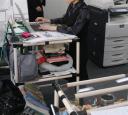Yesterday I told you the plan for today. Here is what really happened.
We got the even pitch going for a while. I was at the front of the line releasing units down the line as the pre-build Team Member was done with them. I was watching distance (since distance = time on a moving line). As the previous unit hit the pitch first pitch line, I launched the next. One of the little discoveries was that the conveyor has a “slow spot” that really changes the speed. Oh – and that happens to be when we measured the speed yesterday. Net result? The units were actually fired down line about 10% faster than they should have been. Oops.
Next discovery? Nobody noticed. So much for this great labor bottleneck. There were line stops, but they had nothing to do with this.
In the first position, our experiment to actually present parts at the point of use cut the team members’ work cycle. How much depends on the situation. His work cycle previously varied all over the place – easily by 100% or more when he had to go look for parts and wasn’t sure where they were.
By simply stabilizing his work, we cut his cycle time to well under the takt.
We ended up not recording line stops, but on the other hand, there weren’t any actual andon calls today. That is both good news – nothing we did really disrupted things – and bad news – their system has serious issues, and none of them trigger andon calls.
The kaizen team members studying the semi-automated test operation designed and proved a work sequence that not only handled this bottleneck process, they cut it nearly in half. It can be done well under the takt time if the Team Member and supervisor don’t panic and try to work ahead. If they do, it disrupts everything for two or three units. To “pay” for this improvement, the kaizen team members shifted a (very) small amount of work to the next position down line. All he has to do is disconnect the test equipment. That gives our team member of focus the time to start the next unit right away. Disconnection takes only a few seconds, and easily fits into the work cycle of this team member.
Another sub-team worked on the sub-assembly process with similar results to the first team. By actually making sure all of the parts are present and presented well, the terrifically unstable cycle started to get consistent. There is a lot of work here, and honestly I think the best solution is to break up the sub-assembly cell and get these processes operating right next to the assembly line. There are huge advantages in information flow (they could just look upline by two units and see what they needed to start next). There are huge advantages in material conveyance – there isn’t any. Quality issues would be spotted immediately and could be addressed immediately. Lots of other advantages as well.
This evening we worked on the final report-out. Since this is a Shingijutsu event, there is a fairly rigid pattern for how these report-outs should go. The team spent until about 10:30 working on it and having it reviewed by sensei. I think we got off pretty clean in that department since I already knew the drill, coached the team on what was important plus sensei knows me from past events. I have seen draft report-outs thrown across the room in the past – not especially effective communication in the details, but the big picture, “this is not acceptable,” gets across fairly clearly. That didn’t happen this time. I think Shingijutsu as a company, is mellowing out a little. It is too hard to actually say, but time will tell.


